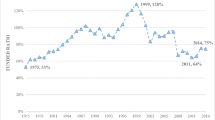Abstract
This paper examines the robustness of the results of adoption date choice studies to sample selection criteria, variable set, and the approach to model building. We use the new pension accounting standard (SFAS 87) in our examination. To this end, we develop a model of the relationship between the adoption date of the pension standard and the variables commonly used in adoption date studies. The variables are: (1) Firm size (2) income change prior to the adoption date and proxies for income management; (3) tightness of debt constraints; and (4) extent of the impact of the standard on financial statements.
The results are consistent with the smoothing and compensation hypotheses, but not with the size hypothesis. Debt constraints did not have a significant effect on the selection of the adoption date; but, to the extent that the funding status of pension plans is a measure of the income effect of SFAS 87, the results are also consistent with the selection of adoption date to ease accounting-based debt constraints.
Further tests indicate that the results of adoption date choice studies depend on the sample selection critiera, the variable set, and the approach to model building. Future researchers should be aware of the sensitivity of the results to these factors.
Similar content being viewed by others
References
Ayres, F., “The Characteristics of Firms Electing Early Adoption of SFAS 52.” Journal of Accounting and Economics 8, 143–158, (June 1986).
Berin, B. and D. Gerboth, “Is FAS 87 Workable?” Financial Executive 3, 18–22, (September/October 1987).
Dopuch, N., R. Holthausen, and R. Leftwich, “Predicting Audit Qualifications with Financial and Market Values.” Accounting Review 62, 431–454, (July 1987).
Draper, N. and H. Smith, Applied Regression Analysis. New York: John Wiley and Sons, 1981.
Duke, J. and H. Hunt III, “An Empirical Examination of Debt Covenant Restrictions and Accounting Related Debt Proxies.” Journal of Accounting and Economics 12, 45–64, (January 1990).
Feuer, P., “Pension Volatility: Statement No. 87 Causes a Host of New Concerns for Fund Managers.” Pension Management 3, 31–33, (January 1987).
Francis, J., “Lobbying Against Proposed Accounting Standards: The Case of Employer's Pension Accounting.” Journal of Accounting and Public Policy 6, 35–57, (Spring 1987).
Gujarathi, M. and R. Hoskin, “Evidence of Earnings Management by the Early Adopters of SFAS 96.” Accounting Horizons 6, 18–31, (December 1992).
Healy, P., “The Effect of Bonus Schemes on Accounting Decisions.” Journal of Accounting and Economics 7, 85–107, (April 1985).
McNichols, M. and G. Wilson, “Evidence of Earnings Management from the Provision for Bad Debts.” Journal of Accounting Research Supplement 26, 1–40, (1988).
Noreen, E., “An Empirical Comparison of Probit and OLS Regresson Hypothesis.” Journal of Accounting Research 26, 119–133, (Spring 1988).
Norton, C., “Transition to New Accounting Rules: The Case of FAS 87.” Accounting Horizons 40–48, (1989).
Press, E. and J. Weintrop, “Accounting-Based Constraints in Public and Private Debt Agreements.” Journal of Accounting and Economics 12, 65–95, (January 1990).
Ralston, F. and J. Cassidy, “Statement of Financial Accounting Standard No. 96: Characteristics of Early Adopters.” Proceedings of the National Meetings of the American Accounting Association 203, (1990).
Salatka, W., “The Impact of SFAS No. 8 on Equity Prices of Early and Late Adopting Firms: An Events and Cross-Sectional Analysis.” Journal of Accounting and Economics 11, 35–69, (February 1989).
Senteney, D. and J. Strawser, “An Investigation of the Association Between Financial Statement Effects and Management's Early Adoption of SFAS 87.” Review of Business and Economic Research 25, 12–22, (Spring 1990).
Stone, M. and J. Rasp, “Tradeoffs in the Choice Between Logit and OLS for Accounting Choice Studies.” The Accounting Review 66, 170–197, (January 1991).
Trombley, M. A., “Accounting Method Choice in the Software Industry: Characteristics of Firms Electing Early Adoption of SFAS No. 86.” The Accounting Review 64, 529–538, (July 1989).
Walker, D., “Statements 87 and 88: The Erisa Implications.” Financial Executive 4, 10–14, (September/October 1988).
Watts, R. and J. Zimmerman, Positive Accounting Theory. Englewood Cliffs, NJ: Prentice Hall, 1986.
Author information
Authors and Affiliations
Rights and permissions
About this article
Cite this article
Espahbodi, R., Hamer, M.M. On the robustness of the results of adoption date choice studies: The case of pension accounting. Rev Quant Finan Acc 6, 63–77 (1996). https://doi.org/10.1007/BF00290797
Issue Date:
DOI: https://doi.org/10.1007/BF00290797




